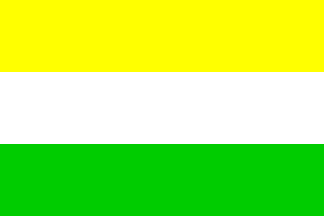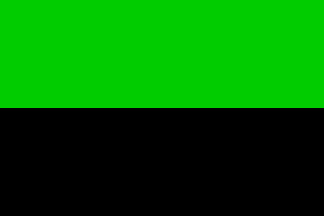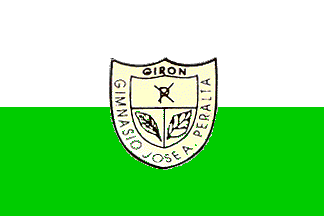
image by Eugene Ipavec, 20 February 2006

Last modified: 2009-08-08 by dov gutterman
Keywords: education |
Links: FOTW homepage |
search |
disclaimer and copyright |
write us |
mirrors
See Also:

image by Eugene Ipavec, 20 February 2006
Some background from the university website:
"The Colombian Polytechnic Jaime Isaza Cadavid is a Public
University Institution, funded by the departmental government of
Antioquia. Founded in 1964, the Polytechnic now caters for
approximately 13,200 students. The main campus is situated in El
Poblado, in the city of Medellín, and counts on 1,300
educational and 350 administrative staff, as well as its
three academic centers in other municipalities of the department
of Antioquia.
The Polytechnic is a national leader in technological education
and at present offers higher education at technological,
technical and academic levels with a range of pregraduate and
postgraduate courses in areas such as Engineering,
Administration, Agrarian Sciences, Audiovisual Communication,
Sport and Recreation. These programs are supplemented by various
extension, continued education and informal courses available to
the general public."
"Poli" is named after Jaime Isaza Cadavid (1919-1965).
Cadavid studied in the Faculty of Law of the University of
Antioquia. He had liberal leanings and was elected Deputy at the
Departmental Assembly of Antioquia, (Municipal?) Councillor in
Fredonia and Antioquia, Deputy at the Chamber and Senator of the
Republic. He served as Dean and Professor ad Honorem in the
Faculty of Law of the University of Medellín. He significantly
contributed to the foundation of "Poli"; by Order 11 of
30 November 1965, his name was given to "Poli" as a
posthumous tribute.
The flag of "Poli" recalls the shield of the
University, which is per fess or and vert with additional
charges. Or/yellow symbolizes strength of the students whereas
Vert/green symbolizes hope and confidence in the future.
Source: <www.politecnicojic.edu.co>,
located by Valentin Poposki, 18 February 2006.
Ivan Sache, 25 February 2006.and 20 December 2008

image by Carlos Thompson, 27 May 2003
"Pontificia Universidad Javeriana" is a catholic
university dated from 1621. You can find the flag and symbols of
this university <www.javeriana.edu.co>.
Jorge Eduardo Alonso, 8 June 2002
The flag of the University is made of three horizontal stripes
yellow, white and blue, of equal width. The flag is presecribed
by General Regulation #794.
As pointed out by Jorge, the University has a very long history,
divided into two distinct periods:
1621-1767 - Pope Gregor XV allowed the Jesuits to found
universities in South America by a brief dated 9 July 1621. The
"Academia de San Francisco Javier", named after St.
Francis-Xavier, was confirmed by an order of King of Spain Philip
III dated 2 March 1622. On 23 June 1704, Pope Clement XII granted
the "Academia" the title of "Public
University". The first period of the University ended on 1
July 1767, when King of Spain Charles III expelled the Jesuits
from his dominions.
1930 - The University was reestablished on 1 October 1930. On 31
July 1937 (St. Ignatius of Loyola's Day), the University was
granted by the Holy See the title of "Pontifical
University". Its current statute was approved by the Holy
See on 27 April 1978 and by Resolution # 5117, dated 16 May 1985,
signed by the Minister of National Eductaion of Columbia.
Ivan Sache, 9 June 2002
Concering Pontificia Universidad Javeriana, Bogotá, the site
just says "blue", but the shade I have always seen
flying is light sky blue (together with the Vatican and Colombian
flags). Pontificia Universidad Javeriana, Cali, Valle del
Cauca is actually the same University as Javeriana Bogotá, but
has a lot of authonomy. The simbols, incliding the flag,
are the same. In the website <www.puj.edu.co>
they do use the light shade of blue.
Carlos Thompson, 27 May 2003
I study at the PUJ and the flag that I've seen, which is flown
rarely (at beginning of semesters, when an important jesuit dies
etc.), use the same shade of blue than that of the Colombia flag.
Jaime Vengoechea, 10 June 2003
I am based mostly on memory (I am Javeriano too) and on these
pictures: <sparta.javeriana.edu.co//img1.jpg>
and <img5.jpg>.
Carlos Thompson, 10 June 2003

image by Carlos Thompson, 22 July 2003
I was today at my University and it was an interesting display
of flags. On each pole set, they had flying the flags of Colombia
(in the middle), the University (at the viewers left) and the
Vatican (without the charge: plain yellow and white per pale; at
the right). Also, on every mast there was two vertical flags
framed: the University's and the Colombian flag. (Javeriana
flag at viewers left, and top to the left in both flags).
The shade of blue on all those flags was the same shade as the
Colombian flag (some times it seem slightly lighter, but
definitively it was not sky blue).
Carlos Thompson, 22 July 2003

image by Ivan Sache, 5 February 2009
"Colegio Parroquial 'Jesús de la Buena Esperanza'"
(Jesus of Good Hope) was founded in 1959 by Priest Carlos Gustavo
Pérez Mejía (1918-1976) in Bello, Department of Antioquia.
The flag of the institute, as shown gaphically and described on
the website
of the institute, is horizontally divided yellow-green.
Yellow represents wisdom, wealth and the Eucharist. Green
represents hope, liberty and joy.
Ivan Sache, 5 February 2009

image by Ivan Sache, 7 February 2009
"Institución Educativa 'Joaquín de Cayzedo y
Cuero'" was founded, as "Colegio del Barrio Cristóbal
Colón", affiliated to "Instituto Politécnico
Municipal", in Borough Cristóbal Colón, Municipality of
Cali, Department of Valle del Cauca, on 15 October 1964 (Decree
No. 0750). On 8 March 1965 (Decree No. 0623), the
institute was renamed "Colegio 'Joaquín de Cayzedo y
Cuero'"; on 8 April 1966 (Decree No. 0406), it became
independent from "Instituto Politécnico Municipal".
The institute is named after the politician Joaquín de Cayzedo y
Cuero, who presided the Extraordinary Assembly that gathered in
Cali on 3 July 1810 and issued what is often, seemingly
erroneously, considered as the first independence declaration of
Colombia. See: <www.elpais.com.co>.
The flag of the institute, as shown graphically
and on a photo
on the website of the institute, is horizontally divided
yellow-white-green.
Ivan Sache, 7 February 2009

image by Ivan Sache, 30 January 2009
"Institución Educativa Técnica 'Joaquín París'"
was created at Ibagué, Department of Tolima, on 2 October 2002
(Decree No. 1216), transforming "Centro Auxiliar de
Servicios Docentes de Ibagué" into a full-fledged
educational institute. General Joaquín París y Ricaurte
(1795-1862), a hero of the War of Independence, was appointed
Vice-President of Colombia in 1855. On 24 June 1983, for the
celebration of the 200th anniversary of Simón Bolívar, the
names of several of his brothers-in-arms were given to
educational institutes.
The flag of the institute, as shown graphically on the website
of the institute, is horizontally divided green-white.
Ivan Sache, 30 January 2009

image by Ivan Sache, 3 January 2009
"Colegio Jordán de Sajonia" was recognized by the
Ministry of National Education on 18 May 1998 (Decree No. 3417).
as the legal successor of "Escuela Apostólica San Vicente
Ferrer", originally founded in the Colombian Marian town of
Chiquinquirá, Department of Boyacá, in the 1940s. On 29
September 1959, the new building of the institute, which had been
relocated in Bogotá in 1949, was inaugurated and the institute
was renamed after Blessed Jordan of Saxony (c. 1190-1237), second
Master General of the Dominican Order and first successor of St.
Dominic. The institute is one of the six "colegios"
ran by the Dominican Order, together with the
"Universidad Santo Tomás", in
Colombia (Province of San Luis Bertrán of the Order).
The flag of the institute, as shown graphically and described on
the website
of the institute, is green with a triangle horizontally
divided black-white placed along the hoist and
pointing to the coat of arms of the institute, which is,
apparently, placed in the middle of the flag.
Green represents virtue and hope. Black and white are the colours
of the Dominican Order.
Black, as absorbing light, represents interiorization and
appropriation of knowledge.
White, as the lack of colour and the plenitude of light,
represents truth revealed to mankind and enlightening it.
The coat of arms of the institute was designed by Friar Alberto
Epaminondas Ariza, who was in charge of the transfer of the
institute to its new site in the 1950s. The shield is
horizontally divided, on top a half Cross of Calatrava, which is
the coat of arms of the Dominican Order, on bottom a landscape
showing a green oak in front of green mountains surmonted by a
blue sky with three white clouds. The oak represents the firmness
of the education program of the college, expected to raise the
students up to mountains where they will challenge storms.
The shield is surmonted by a scroll bearing a star symbolizing
St. Dominic and the motto of the college, "STEMUS
SIMUL" ("Let us stand together", Isaiah 50.8),
adopted in 1954. The border is coloured or (dexter) and argent
(sinister) to symbolize the rich educationalist tradition of the
Dominican community. The black writing "COLEGIO JORDÁN DE
SAJONIA - DOMINICOS" was added to the border of the shield
in 1997.
Ivan Sache, 3 January 2009

image by Ivan Sache, 9 January 2009
"Instituto Jorge Robledo" was founded in 1949 in
Medellín. The institute is named after the Spanish Marshal Jorge
Robledo (1500-1546), known as "The Conquistador of
Antioquia". The President of the Republic Àlvaro Uribe
Vélez and the cyclist Santiago Botero have studied in the
institute.
The flag of the institute, as shown graphically and described on
the website of
ADER ("Asociación de Robledistas"), is
horizontally divided red-green with a yellow square canton.
Red represents the youth's ardor and valor.
Green conveys self-confidence, represents the fecund daily work
and recalls the classic pennant of Antioquia.
Yellow represents purity and firmness required to reach the
objectives.
Ivan Sache, 9 January 2009

Current flag of the University
image by Ivan Sache, 3 December 2005
.gif)
Current emblem of the University
image from the University
website

Former, original flag of the University
image by Ivan Sache, 3 December 2005
The Jorge Tadeo Lozano University of Bogotá
(Universidad de Bogotá Jorge Tadeo Lozano) was founded on 5
February 1954 by Joaquín Molano Campuzano, Javier Pulgar Vidal
and Jaime Forero Valdés. The main goal of the University was
"to continue on the cultural and scientific work initiated
during the Botanical Expedition in the Kingdom of New
Granada." This expedition (Expedición Botánica
del Nuevo Reino de Granada) took place in 1783.
Accordingly, the University is named after Jorge Tadeo Lozano
(1770-1816). Lozano, born in a noble family from Santafé de
Bogotá (today internationally known as Bogotá), studied
chemistry in the Royal Laboratory of Madrid (Spain) and was
appointed Professor of Chemistry in the Colegio de Nuestra Senora
del Rosario in Santa Fé. Lozano took part to the Botanical
Expedition as a zoologist. In 1801, he was visited in Santafé by
the famous naturalists Humboldt and Bonpland. Lozano was also a
patriot. He wrote in 1811 a proposal of liberal Constitution and
set up an alliance with Venezuela, which is considered as the
first attempt of pan-Americanism. In 1814, Lozano published with
José Ángel Manrique the struggle newspaper "El anteojo de
larga vista"; he was elected Representative of the Province
of Chocó at the General Congress gathered in Santafé. Lozano
was arrested and sentenced to death in 1816 with other patriots;
he was shot on 6 July 1816. One of the founders of the
University, Joaquín Molano, is a descendant of Joaquín Gómez
Hoyos, husband of María Tadea Lozano e Isasi, Lozano's widow.
The first faculties of the University, which is nicknamed
"la Tadeo", opened in 1955. The University increased
with time and more faculties were incorporated. In 1962, the
Faculty of Marine Sciences initiated teaching of Aquaculture and
Oceanography in Colombia. The bicentenary of the Botanical
Expedition was celebrated in 1983 with the structuration of the
University into three academic areas recalling the goals of
the Expedition: Engineering and Natural Resources
(Agricultural Management, Marine Biology, Food Science, Agrology
and Geography), Law and Economics (Law, Management, Information
Systems, International Trade, Public Accounting, Economics,
Market, International Relations, Foreign Trade and Tourism) and
Arts, Design and Communication (Architecture, Interior Design,
Fine Arts, Social Communication, Graphic Design, Industrial and
Commercial Design). Some faculties have been relocated in
Cartagena and Santa Marta.
The flag of the University is blue with the emblem of the
University in the middle. This flag was adopted by the Board of
the University on 1 December 2001 (Decree #19). It superseded the
former, original flag of the University, which was horizontally
divided green-black.
The University used three successive emblems. The first, original
emblem shows a green star with the white letters UJTL, the
acronym of the University, supported by a stylized bird (?). This
emblem is based on the emblem of the Peruvian party APRA, itself based on the Halcón from
the local culture Chavin from Huantar. It recalls the strong
Indo-American feelings of APRA, shared by the founders of the
University.
The second emblem of the University was proposed by Dr. Fabio
Lozano y Lozano, President of the Board of the University and
member of the International Institute of Genealogy and Heraldry,
and approved by the Board on 13 June 1960. The shield is:
"El de Bogotá, teniendo en cuenta el nombre de la misma y
el hecho de haber sido fundada en esta ciudad". (The
[shield] of Bogotá, because of bearing the name of the city and
having been founded in the city). The graphical design of the
emblem was made by the artist César Pedraza, alumnus of the
Faculty of Geography of the University. The shield of the
University differs from the standard coat
of arms of Bogotá by its Spanishized shape and some further
details. The original shield of Santafé de Bogotá was granted
by Emperor Charles V for the whole Kingdom of New Granada, by
patented letters signed on 3 December 1548 in Valladolid:
"… por sus armas conocidad un escudo que en medio dél
haya una águila negra rampante entera, coronada de oro, que en
cada mano tenga una granada colorada en campo de oro, y por erla
unos ramos con granadas de oro en campo azul …". The
eagle (águila) symbolizes greatness and noble view; as portrayed
on the shield, it is an adaptation of Isobel the Catholic's
eagle. The shield is crowned by a Duke's coronet, as it is often
the case on the shield of Spanish cities.
The third, currently in use, emblem of the University was
proposed by Dr. Alfonso Velasco Rojas, Head of the Department of
Publishing and Corporate Emblematic of the University and
approved by the Board on 1 August 2000 (Decree #13). The
graphical design of the emblem was made by Felipe Duque Rueda.
The shield of the University is surrounded by a ring bearing the
name of the University and flanked by the year of foundation: 19
(left) 54 (right). The whole emblem is coloured in blue; the name
of the University is written below the emblem in black. The
representation of the shield has been improved compared with the
second version of the emblem of the University. The multicoloured
version of the emblem shall be used only in the official
documents of the University released by the Rectorate and the
General Secretariat. The flag of the University features that
coloured version of the emblem.
Source: Universidad
de Bogota Jorge Tadeo Lozano, located by Valentin Poposki.
Ivan Sache, 3 December 2005

image by Ivan Sache, 10 January 2004
The College is located in Giron, Santander department. Its
flag is horizontally divided yellow-green with the College emblem
in the middle.
Source: <www.voluntad.com.co>,
located by Dov Gutterman.
Ivan Sache, 10 January 2004

image by Ivan Sache, 13 January 2009
"Colegio de Educación Básica y Media Técnica 'José
Benigno Perilla'", founded in Somondoco (Department of
Boyacá) by María Lidia Puentes González (b. 1939), was
recognized on 10 August 1962 by the Department of Boyacá (Decree
No. 546), as "Escuela Normal Superior Femenina 'José
Benigno Perilla' de Somondoco". The institute is named after
José Benigo Perilla (1831-1893), second Archbishop of Tunja
(1887-1893).
The flag of the institute is shown graphically on the website of the
institute, as horizontally divided white-green with the
emblem of the institute in the middle. White means purity while
green means hope. The written description does not mention the
emblem; moreover, the flag is said to have been officially
approved in 1970 whereas the emblem was designed in 1981.
Therefore I beleive that the flag actually used is without the
emblem.
The emblem of the institute was designed in 1981 by student
Abraham Sánchez Sánchez. The shield is divided into four
concave quarters by a red cross. The upper left quarter shows a
white open book on a green field. The upper right quarter shows a
red quill and inkpot on a hwite field. The lower left quarter
shows a red torch on a white field. The lower right quarter shows
a white diploma on a green field. A white escutcheon charged with
a green pair of scales is placed in the middle of the shield. The
shield is topped by a golden mural crown. The green
writing "Colegio de Educación Básica y Media
Técnica José Benigno Perilla Somondoco Boyacá" is placed
on a scroll under the shield. The cross recalls the cultural
heritage and, especially, His Grace José Benigno Perilla; red
symbolizes the sacrifice and constancy expected form the
students. The book is the symbol of science, culture and work.
The quill and inkpot symbolize empowerment, commitment and
creativity. The torch is the symbol of knowledge and eternal
spitritual light. The diploma symbolizes abnegation and great
expectations. White and green are taken from the flag of the
institute.The pair of scales represents commerce. The mural crown
represents integrity, firmness and education expected to form a
fortress. Gold is the symbol of obedience.
Ivan Sache, 13 January 2009

image by Ivan Sache, 13 January 2009
"Colegio Nacional 'José Maria Córdoba'" was
founded in 1946 in Montería, Department of Córdoba, as
"Colegio de Segunda Enseñenza", and renamed in 1953
"Colegio Nacional 'José Maria Córdoba'" (CONALCO). In
1962, the institute housed the emerging "Universidad
Nacional de Córdoba".
The institute is named after General José Maria Córdova
(1799-1829), a hero of the Wars of Independence against Spain.
The Department of Córdoba was also named after him.
The flag of the institute, as shown and described on the website of the
institute, is horizontally divided yellow-red-green.
The colours are inspired by the "national symbology".
Yellow represents the Colombian people, red the blood shed in the
struggle for sovereignty, and green the aspiration to liberty.
The colours also represent the profil of the educationalist
collectivity. Yellow represents light, dynamism and a center of
resource and cultural material. Red means distinction and joy of
life in an atmosphere of affect and vital reason. Green
represents the natural environment.
Ivan Sache, 13 January 2009

image by Ivan Sache, 30 January 2009
"Institución Educativa 'José Prieto
Arango'" is located at Tarso, Department of
Antioquia.
The institute is named after José Prieto Arango, one of the
founders of the journal "La Tarde" in the neighbouring
town of Jericó in the early 20th century.
The flag of the institute, as shown graphically and described on
the
website of the institute, is horizontally divided
blue-white-yellow.
The flag was designed in 1988 by teachers Marco Tulio Hurtado and
Alirio Palacio.
Blue, the colour of heavens, symbolizes highness, desire, spirit
and ideal of commitment to be shared by the students.
White, the colour of purity, symbolizes honesty in all our acts.
Yellow, the colour of light, symbolizes intelligence, creativity
and dynamism of the youth.
The stripes are equal and horizontal to represent the equity in
rights among the students.
Ivan Sache, 30 January 2009

image by Ivan Sache, 31 January 2009
"Institución Educativa 'Juan XXIII'" was formed in
Monteria, Department of Córdoba, on 3 March 1997 (Decree No.
556), through the merging of "Escuela Urbana Mixta Juan
XXIII" and "El Rosario". The institute is named
after Pope John XXIII (1881-1963, Pope in 1958, blessed in 2000).
The flag of the institute, as shown graphically on the website of the
institute, is horizontally divided white-blue.
Ivan Sache, 31 January 2009
"Colegio 'Juan Lozano y Lozano'" was founded in 1984
in Bogotá. The institute is named after the poet, diplomat and
journalist Juan Lozano y Lozano (1902-1980).
The flag of the institute, according to a photo and the description
available on the website
of the institute, is red with the emblem of the institute in
the middle.
The emblem shown on the flag shows some differences with the
emblem shown graphically on the website of the institute. It is
made of a yellow triangle charged with stylized black letters
"JLL" and inscribed in a white disk. The red border of
the disk bears the black writing "COLEGIO DISTRITAL"
(top) / "JUNA LOZANO Y LOZANO" (bottom). There is
something written in black under the triangle, ending with
"...ITUD".
The emblem shown on the website has the white writing
"INSTITUCION EDUCATIVA DISTRITAL / JUAN LOZANO Y
LOZANO" and nothing written under the triangle. Therefore,
it seems that the flag was not "updated" when the
satutes and name of the institute were changed.
Ivan Sache, 17 January 2009

image by Jairo Alonso Méndez Méndez, 15 March 2005
Here is the flag of the Colegio Departamental Julio César
Sánchez García, in Anapoima (Cundinamarca). The flag was
officialized after a concourse, in 1998, and have a version with
the 1998 Coat of Arms and 2001 Coat of Arms.
Jairo Alonso Méndez Méndez, 15 March 2005